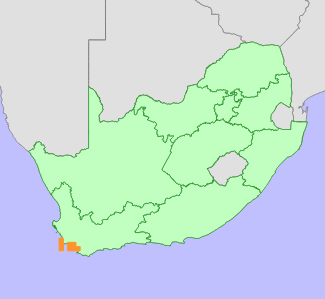|
Scientific Name | Ficinia pinguior C.B.Clarke |
Higher Classification | Monocotyledons |
Family | CYPERACEAE |
National Status |
Status and Criteria | Vulnerable B1ab(ii,iii,v)+2ab(ii,iii,v) |
Assessment Date | 2008/03/14 |
Assessor(s) | M. Muasya & D. Raimondo |
Justification | EOO 1250 km², known from 10 locations. Experiencing an ongoing loss of habitat due to coastal development and associated lack of fire and alien plant invasion. |
Distribution |
Endemism | South African endemic |
Provincial distribution | Western Cape |
Range | Cape Peninsula to Kleinmond. |
Habitat and Ecology |
Major system | Terrestrial |
Major habitats | Peninsula Sandstone Fynbos, Overberg Sandstone Fynbos, Kogelberg Sandstone Fynbos, Hangklip Sand Fynbos, Cape Flats Sand Fynbos |
Description | Flats and slopes below 700 m in fynbos. |
Threats |
| Habitat loss to development and urban expansion on the Cape Peninsula and around Cape Hangklip and Betty's Bay has already caused extensive declines, and loss is continuing. This species is stimulated by fire, but as a result of development, fire is often excluded from lower slopes to protect valuable properties. Invasive alien plants are also causing habitat degradation in some areas. |
Population |
Population trend | Decreasing |
Assessment History |
Taxon assessed |
Status and Criteria |
Citation/Red List version | | Ficinia pinguior C.B.Clarke | VU B1ab(ii,iii,v) | Raimondo et al. (2009) | |
Bibliography |
Goldblatt, P. and Manning, J.C. 2000. Cape Plants: A conspectus of the Cape Flora of South Africa. Strelitzia 9. National Botanical Institute, Cape Town.
Raimondo, D., von Staden, L., Foden, W., Victor, J.E., Helme, N.A., Turner, R.C., Kamundi, D.A. and Manyama, P.A. 2009. Red List of South African Plants. Strelitzia 25. South African National Biodiversity Institute, Pretoria.
|
Citation |
| Muasya, M. & Raimondo, D. 2008. Ficinia pinguior C.B.Clarke. National Assessment: Red List of South African Plants version 2024.1. Accessed on 2025/11/06 |
 Comment on this assessment
Comment on this assessment


